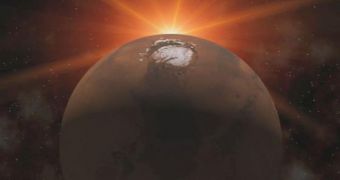Astronauts could survive long-time Mars missions without being affected by a dangerous amount of radiation, new Curiosity rover findings show.
The new study suggests that an astronaut can undertake a mission consisting of a 360-day on-board journey: 180 days to arrive on Mars, 180 days to get back to Earth, and a 600-day stay on the Red Planet and he would receive a radiation dose of no more than 1.1 sieverts.
The amount wouldn't put an astronaut's life in danger, since it doesn't exceed the radiation limit officially stated by NASA.
“The rough ballpark average for an astronaut career limit is on the order of a sievert,” said Don Hassler, scientist at the Southwest Research Institute In Boulder, Colorado.
Analyses made by RAD, Curiosity's Radiation Assessment Detector, reveal that the amount of radiation on Mars is similar to the one registered in the low-Earth region, Space reports.
RAD observations also show that despite the Martian atmosphere's thickness, its protective action against the noxious particles outside it is pretty high.
Scientists say that radiation is much more dangerous during the space journey to Mars than during the actual stay on the planet. It was estimated that people traveling to Mars would have to face a radiation dose of about 1.9 millisieverts per day.
“We can survive the Mars surface. The hard part is the cruise,” declared Hassler.
However, researchers admit that the information about the radiation dose during space flight, as RAD reveals it, is far from being complete. Numerous unpredictable events, such as solar storms or galactic cosmic rays variation could determine the radiation level to change along the way.
Previous Mars radiation measurements were made as part of different space missions. The most significant one was the science mission of the 2001 Mars Odyssey, when NASA designed MARIE – the Martian Radiation Experiment – to determine the radiation level of Mars' surface using a spectrometer based on energetic particles.

 14 DAY TRIAL //
14 DAY TRIAL //